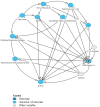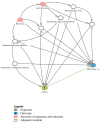COPD in Never-Smokers: BOLD Australia Study
- PMID: 38249822
- PMCID: PMC10800088
- DOI: 10.2147/COPD.S439307
COPD in Never-Smokers: BOLD Australia Study
Abstract
Purpose: Tobacco smoking is the major risk factor for COPD, and it is common for other risk factors in never-smokers to be overlooked. We examined the prevalence of COPD among never-smokers in Australia and identified associated risk factors.
Methods: We used data from the Australia Burden of Obstructive Lung Disease (BOLD) study, a cross-section of people aged ≥40 years from six sites. Participants completed interviews and post-bronchodilator spirometry. COPD was primarily defined as an FEV1/FVC ratio <0.70 and secondarily as the ratio less than the lower limit of normal (LLN).
Results: The prevalence of COPD in the 1656 never-smokers who completed the study was 10.5% (95% CI: 9.1-12.1%) [ratio<LLN 4.6%]. The likelihood of having COPD increased with advancing age [odds ratio (OR) 4.11 in those 60-69 years and OR 8.73 in those 70 years and older], having attained up to 12 years of education (OR 1.75) compared to those with more than 12 years, having a history of asthma (OR 2.30), childhood hospitalization due to breathing problems before age 10 years (OR 2.50), or having a family history of respiratory diseases (OR 2.70). Being overweight or obese was associated with reduced prevalence of COPD compared with being normal weight. In males and females, advanced age, a history of asthma, and childhood breathing problems before age 10 were factors that elevated the likelihood of COPD. However, in males, additional factors such as a higher body mass index and a family history of respiratory diseases also contributed to increased odds of COPD.
Conclusion: COPD was prevalent in this population of never-smokers aged 40 years and over. This finding highlights the significance of risk factors other than smoking in the development of COPD.
Keywords: BOLD; LLN; burden of obstructive lung disease; lower limit of normal; non-smokers; prevalence; spirometry.
© 2024 Ivey et al.
Conflict of interest statement
Guy B Marks has provided independent medical service on an advisory board for Astra Zeneca. Michael J Abramson holds investigator-initiated grants for unrelated research from Pfizer, GSK, Boehringer-Ingelheim and Sanofi and he has also conducted an unrelated consultancy for Sanofi. He has also received a speaker’s fee from GSK. The other authors declare no conflicts of interest. The funders had no role in the design of the study; in the collection, analyses, or interpretation of data; in the writing of the manuscript or in the decision to publish the results. The other authors declare no conflicts of interest.
Figures
References
-
- WHO Global Health Estimates. The top 10 causes of death. Available from: https://www.who.int/news-room/fact-sheets/detail/the-top-10-causes-of-death. Accessed July 1, 2021.
-
- Australian Institute of Health and Welfare. Deaths in Australia Australian institute of health and welfare. Available from: https://www.aihw.gov.au/reports/life-expectancy-death/deaths/data. Accessed October 5, 2020.
-
- Australian Bureau of Statistics. Twenty years of population change (feature article); 2019. Available from: https://www.abs.gov.au/ausstats/abs@.nsf/0/1cd2b1952afc5e7aca257298000f2e76. Accessed July 4, 2021.



